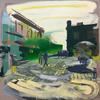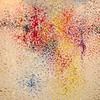Kunstmuseum Basel Presents Dual Exhibitions on Sam Gilliam and Theaster Gates
- BASEL, Switzerland
- /
- June 12, 2018
With international fair Art Basel set to draw crowds this week, Kunstmuseum Basel has opened two exhibitions devoted to leading African American artists, Sam Gilliam and Theaster Gates.
In The Music of Color. Sam Gilliam, 1967–1973, the Kunstmuseum Basel mounts the American artist Sam Gilliam’s (b. 1933)
first institutional solo exhibition in Europe, from June 9–September 30, 2018. The international team of curators has chosen to focus
on the years between 1967 and 1973, the period of greatest creative radicalism in Gilliam’s oeuvre; in 1972, he was the first African-American to represent the United States at the Venice Biennale. A focused selection of forty-five works from international private and public collections introduces visitors to the unique art of an influential painter who is still largely unknown to European audiences. The exhibition also opens up fresh perspectives on the history of abstract painting in the 1960s and 1970s.
Often monumental and colorfully expressive, Sam Gilliam’s works mount a creative challenge to the traditional boundaries between painting, sculpture, and architecture and prompt a fruitful artistic and theoretical debate on these divisions. Responding to the architectural context in the Kunstmuseum’s Neubau, the artist will thoroughly redesign several works for the presentation in
our galleries.
After moving to Washington, D.C. in 1962, Gilliam came into contact with color field painting, and so art historians often associate him with the Washington Color School. Yet rather than follow in the footsteps of Mark Rothko, Louis Morris, and Kenneth Noland, Gilliam soon charted his own course. The wide spectrum of his creative practice between 1967 and 1973 and his groundbreaking achievements are illustrated by two central groups of works: the Slices (or beveled-edge paintings) and the Drapes (or drape paintings).
In 1967, Gilliam started work on the beveled-edge paintings: he poured highly diluted acrylic paint directly onto the unprimed canvas, which he then folded and creased before the paint dried and subsequently stretched over a beveled frame to lend the painting sculptural depth and an objectlike quality. Despite their considerable dimensions, the works seem to float several inches in front
of the wall. The chance patterns and lines that emerged as the paint dried—“slices of color,” in Gilliam’s phrase—form contingent structures. The gestural application of color serves as an index of the creative process and the materiality of canvas and paint, yet without referring to the painter himself. In this respect, Gilliam’s work devises an interesting alternative to contemporary positions
in minimalism and Pop art which sought to eliminate the gestural-expressive trace of the artist’s hand that was the hallmark of abstract expressionism.
The Music of Color also probes the political and cultural-historical dimension of Gilliam’s oeuvre. While the artist himself rarely comments on political issues, selections from the so-called Martin Luther King and Jail Jungle series on display in the exhibition reflect the 1968 race riots. The work titled Composed (formerly) Dark as I am (1968–1974), meanwhile, is an ironic allusion to the highly
polarized debate over black art and the part black artists played in abstract painting in 1960s and 1970s America.
The exhibition will be the Basel debut of Rondo (1971), which was acquired for the Kunstmuseum Basel’s collection in 2017 thanks to the generous support of the Freiwillige Akademische Gesellschaft’s Arnold Rüdlinger Fonds. Outstanding works on loan from international private and public collections including the Museum of Modern Art, New York, the Metropolitan Museum of Art,
New York, and the Smithsonian American Art Museum, Washington, D.C., will round out the presentation.
In conjunction with the exhibition, the book The Music of Color, Sam Gilliam 1967–1973 will be released by Verlag der Buchhandlung Walther König. The volume will include contributions by Josef Helfenstein, Jonathan Binstock, Sam Gilliam, Rashid Johnson, and Lynette Yiadom Boakye.
In the concurrent exhibition Theaster Gates: Black Madonna at the Kunstmuseum Basel, which spreads out across two of the museum’s venues, Theaster Gates (b. 1973) explores the cult surrounding the Black Madonna, showcasing new works made especially for the occasion of the exhibition as well as interactions with works from the collection of the Kunstmuseum Basel curated by the artist. Together with local and international cooperation partners, the artist will engage the viewers in an extensive program of
life performances.
The creative practice of Theaster Gates ranges from urban interventions, performance to pottery making. His work continually aims to bridge the gulf between art and society and establish cultural communities as a way of initiating social, political, and urban change.
For his exhibition at Kunstmuseum Basel Gates explores the figure of the Black Madonna, examining her political, aesthetical and metaphorical power. One point of departure for Black Madonna was Gates’ interest in the cult surrounding black Marian images as sacred, physical objects. Black Madonnas are amongst the most venerated images of Mary in Europe until this day. The byzantine-style icons have been offered votive gifts, dressed and bejeweled, enshrined and carried about in processions. The history of their perception is complex and has varied significantly over time. An important shift occurred during the 19th century: It is no longer a black image of Mary that is spoken of but an image of a black Mary. The color, once a sign of authenticity (being connoted with age and probably Eastern origin) and venerability (her face having darkened through smoke in the chapels over the century, and many Madonnas being repainted black after restoration to maintain their familiar look), was no longer understood that way. As the essentialist concept of race-as-color developed in scientific discourse, the black skin of Mary started to be perceived as a marker of ethnic or racial origin.
Gates’ new works draw from, but should not be directly conflated with this initial historical situation. His idea of the Black Madonna is a multifaceted and a very personal one. The Black Madonna acts as the figurehead, deriving her power from the reunion of objects, installations and performances which raise questions regarding the power and dissemination of images, concepts and perception of race and beauty and relations between sacred objects, works of art and the social sphere of collective experience. The making of objects, Gates argues, is always also a social intervention, since the spheres of artistic and political agency are inextricably
interconnected.
The role of the archive and of archive-making has evolved in Gates’ practice over the years. Being an avid collector of collections and archives of America’s Black culture, Gates has chosen a space in the Neubau of the Kunstmuseum to host the photographic collection of the Johnson Publishing Company. The legendary company was founded by John H. Johnson in 1942 in Chicago, when he decided to initiate the first commercial monthly digest highlighting Black culture and achievement. For over 60 years iconic publications such as Ebony and Jet have been vital media of Black culture in America, vocalizing Black pride with every edition and circulation numbers running in the millions. The businessman succeeded not only in convincing corporate America to advertise in his magazines but, more or less single handedly, created the African-American consumer market.
In Basel, Gates will engage with the Johnson Publishing Company archive containing nearly 4 million images dating from 1945 to the present, shifting his attention to the singularity of these images. The photographs depict historically significant events as well as slice-of-life-moments, personalities and celebrities, politics and politicians, activist movements and everyday Americans. Gates has chosen 13’000 images of black women posing for the early editions of Ebony and Jet to create his very own Black Madonna archive. Only few works in the history of photography cast black female protagonists. This is one of the reasons, why Gates’ selection of images is unique. Whether she are lancing a defiant gaze towards the spectator, with curlers still in her hair, or hurrying down a road clutching books to her chest, for the artist every woman in this archive is a Black Madonna in her own right. Not simply because these are obviously images of black women, but because they are part of what Gates calls the deification of the black body and because they were distributed massively throughout the U.S.A. to be seen, admired and imitated by the readers as part of John Johnson’s agenda to promote positive images of Black life in America, especially in times of harsh segregation.
Collaborations with artists, architects, researchers, and musicians are an integral part of Gates’s work. For his time in Basel, he has drawn up an extensive program of events that will activate the exhibition as a platform for contemplation, concerts, research, and public debates. Expanding beyond the Kunstmuseum, he will also launch joint projects with other local institutions including Jazz Campus Basel, the Basler Papiermühle—Swiss Museum for Paper, Writing and Printing, and the Basler Münster.













